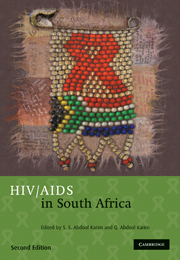Book contents
- Frontmatter
- Contents
- List of Contributors
- Foreword: Peter Piot
- Foreword: Nelson R Mandela
- Acknowledgements
- Section 1 Birth of a rapidly growing epidemic
- Section 2 The virus, the human host and their interactions
- Section 3 HIV risk factors and prevention strategiess
- Section 4 Focal groups for understanding the HIV epidemic
- Section 5 The impact of AIDS
- Section 6 Treating HIV
- Section 7 What does the future hold?
- Index
Foreword: Peter Piot
Published online by Cambridge University Press: 07 September 2011
- Frontmatter
- Contents
- List of Contributors
- Foreword: Peter Piot
- Foreword: Nelson R Mandela
- Acknowledgements
- Section 1 Birth of a rapidly growing epidemic
- Section 2 The virus, the human host and their interactions
- Section 3 HIV risk factors and prevention strategiess
- Section 4 Focal groups for understanding the HIV epidemic
- Section 5 The impact of AIDS
- Section 6 Treating HIV
- Section 7 What does the future hold?
- Index
Summary
South Africa is a dynamic country that has faced – and transcended – extraordinary challenges. Now, 15 years into its new democracy, its future wellbeing – in terms of its prospects for prosperity, for human development, for sustaining that hard-won democracy – hinges on rolling back the aids epidemic.
hiv prevalence levels continue to climb in virtually every age group. National hiv prevalence among pregnant women was 28 per cent in 2007 – with a high of 37.4 per cent in KwaZulu-Natal.
Generations of young people are being decimated. Young women are in greatest peril: more than three quarters of young South Africans living with hiv are female.
The prolonged sickness and death of productive adults is a major blow to many key drivers of development, ranging from human capital to government finances and public services. Recent studies of South Africa have documented that poverty levels remain high and that economic growth is not reaching its true potential. In the long term, if left unchecked, aids can irreversibly damage the country's economy and social fabric.
South Africa possesses the capacity to both curb the epidemic and to minimise its impact – dedicated efforts by its government and civil society are already under way. The most successful efforts to tackle aids are based on evidence. A wealth of essential evidence is available in this book, making it a valuable contribution to the effort against aids in South Africa.
- Type
- Chapter
- Information
- HIV/AIDS in South Africa , pp. 29Publisher: Cambridge University PressPrint publication year: 2010

